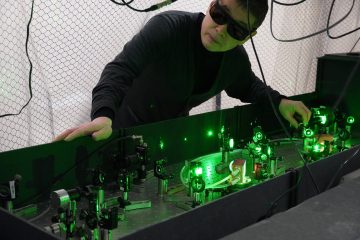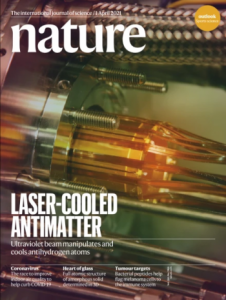Canadian-made laser system cools antimatter close to absolute zero for the first time.
An international group of researchers at CERN’s ALPHA collaboration have successfully cooled antimatter using lasers for the first time. This achievement, published today and featured on the cover of the journal Nature, details the cooling of antihydrogen to near absolute zero with a laser system developed by a team led by Dr. Takamasa Momose.

The ALPHA laser team has been led by Dr. Takamasa Momose.
“Today’s results are the culmination of a years-long program of research and engineering, conducted at UBC but supported by partners from across the country,” said Dr. Momose. “With this technique, we can address long-standing mysteries like: ‘How does antimatter respond to gravity? Can antimatter help us understand symmetries in physics?’. These answers may fundamentally alter our understanding of our Universe.”
10 years after successfully confining antihydrogen for 1000 seconds, the ALPHA collaboration has achieved the world’s first cooling of these particles down to near absolute zero using lasers. In 2018, the ALPHA collaboration was able to excite an important atomic transition of hydrogen, the Lyman-a transition, in antihydrogen which ultimately paved the way for laser cooling of this antiatom.
The findings of this work are impactful since a colder and denser sample of antihydrogen can be trapped for a long duration of time which will enhance spectroscopic and gravitational studies of antimatter. This will aid in answering the long-standing question of gravitational influence on antimatter and why the matter-antimatter asymmetry exists. The manipulation of the motion of antiatoms using lasers, which was demonstrated in this work, may make it possible to create the world’s first antimolecules.
Momose and Fujiwara are now leading a new CFI project, dubbed HAICU, to develop new quantum techniques for antimatter studies. “My next dream is to make a “fountain” of anti-atoms by tossing the laser-cooled antimatter into free space. If realized, it would enable an entirely new class of quantum measurements that were previously unthinkable,” said Fujiwara. “Furthermore, we are one step closer to being able to manufacture the world’s first antimatter molecules by joining anti-atoms together using our laser manipulation technology,” said Momose.
About antimatter
Antimatter particles are identical to matter particles, but they possess opposite charges. Antihydrogen, the simplest antiatom, is composed of one positron and one antiproton, the antiparticles of electron and proton respectively. Antiatoms are exceptionally hard to create, confine and manipulate due to matter-antimatter annihilation. Theories suggest that matter and antimatter should have existed in equal amounts after the Big Bang, though the reason why our Universe, today, is comprised almost entirely of matter remains a great mystery.
About laser Cooling
The so-called Doppler laser cooling had been previously applied to neutral atoms, but this marks the first demonstration of laser cooling of antimatter. This method takes advantage of momentum conservation where the momentum of photons is transferred to antihydrogen upon contact which reduces the velocity of these particles, in turn lowering their temperature. It had been believed that the photon-antimatter momentum exchange is the same as that for photon-matter, though prior to the results published in Nature, no experimental evidence had been obtained to confirm the photon-antimatter momentum exchange which is driven by laser photons.
About ALPHA
ALPHA (Antihydrogen Laser Physics Apparatus) is an international collaboration based at CERN, and which is working with trapped antihydrogen atoms, the antimatter counterpart of the simplest atom, hydrogen. By precise comparisons of hydrogen and antihydrogen, the experiment hopes to study fundamental symmetries between matter and antimatter.

Read the full publication here:
Laser cooling of antihydrogen atoms
Read the CBC article here:
Scientists figure out how to put the brakes on antimatter atoms
Read more press releases here:
ALPHA cools antimatter using laser light for the first time
Canadian-built laser chills antimatter to near absolute zero for first time
World’s First Anti-Molecule Could Become a Reality Thanks to Laser-Cooled Antimatter
Canadian-made laser system cools antimatter close to absolute zero for the first time
Physicists Learn to Superfreeze Antimatter
Scientists Directly Manipulated Antimatter With a Laser In Mind-Blowing First
Researchers achieve world’s first manipulation of antimatter by laser
Antimatter cooled with lasers for the first time